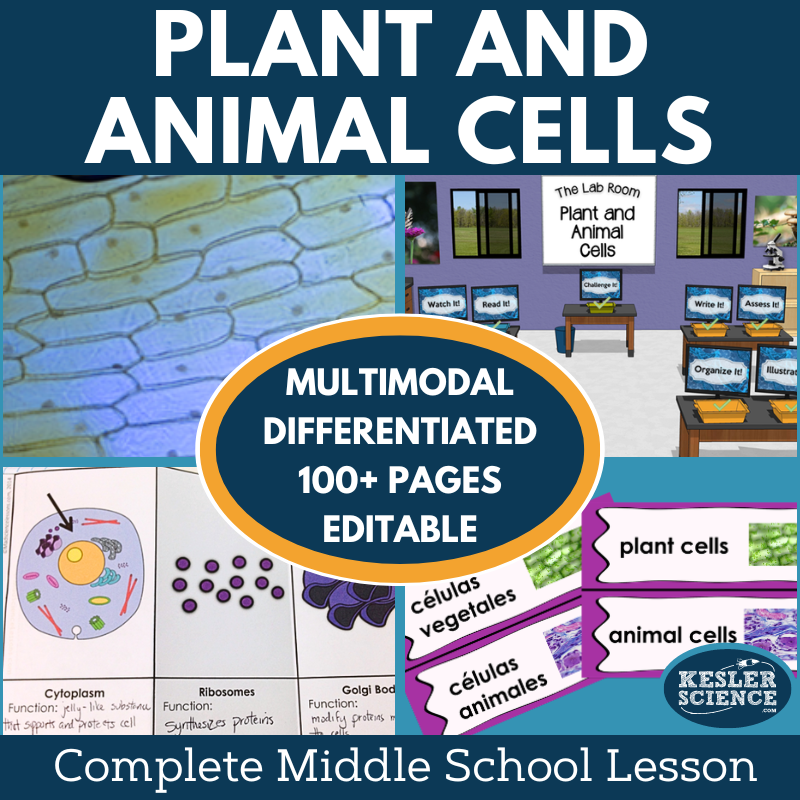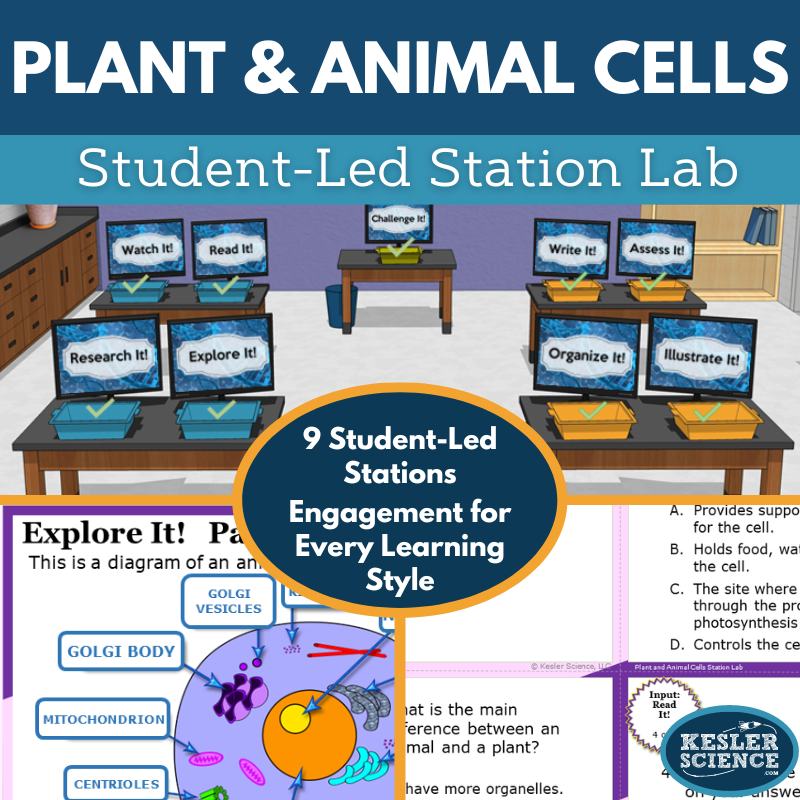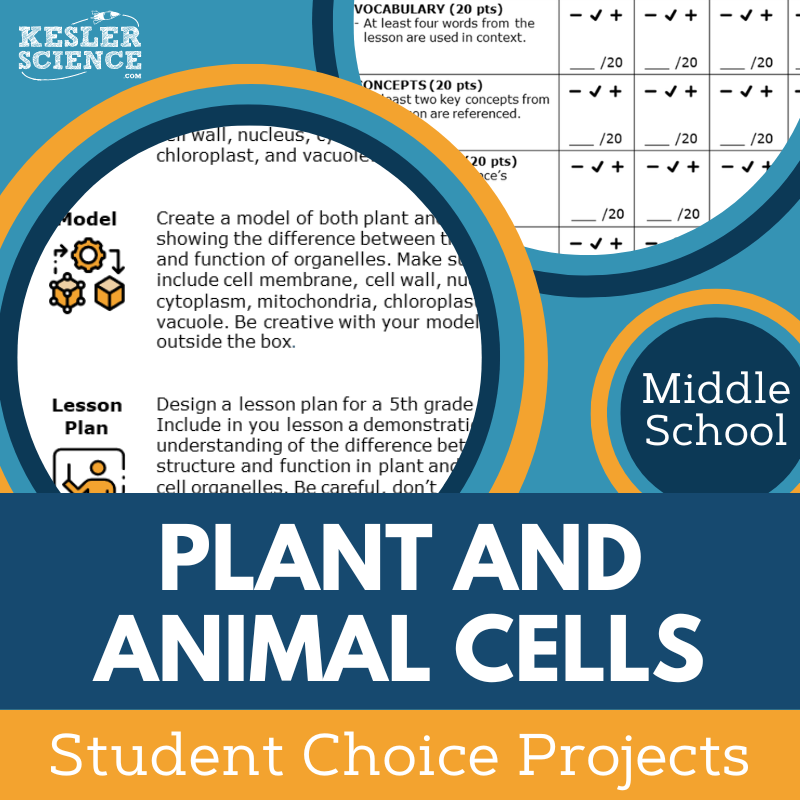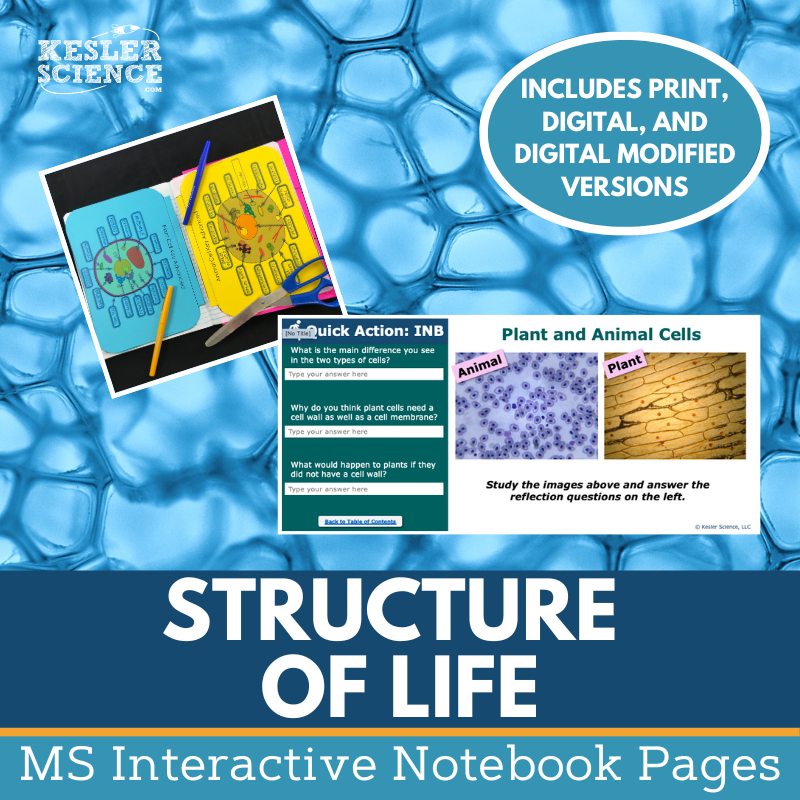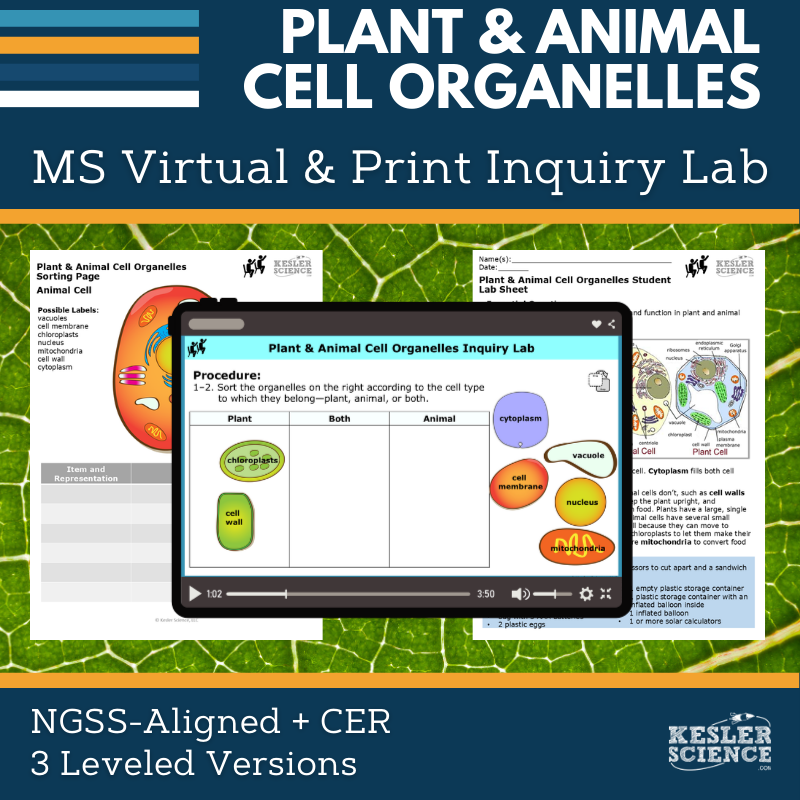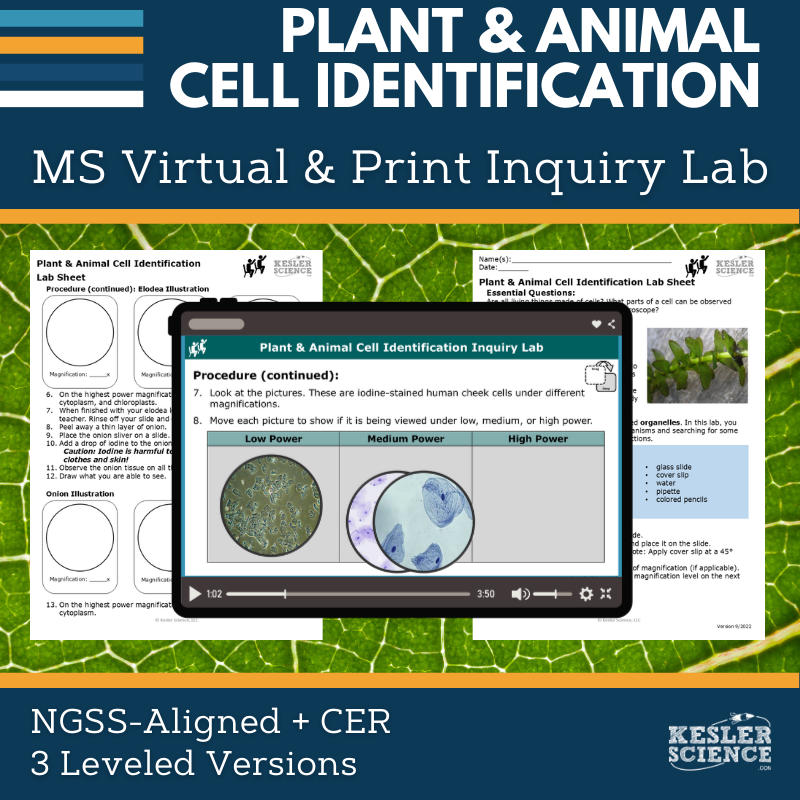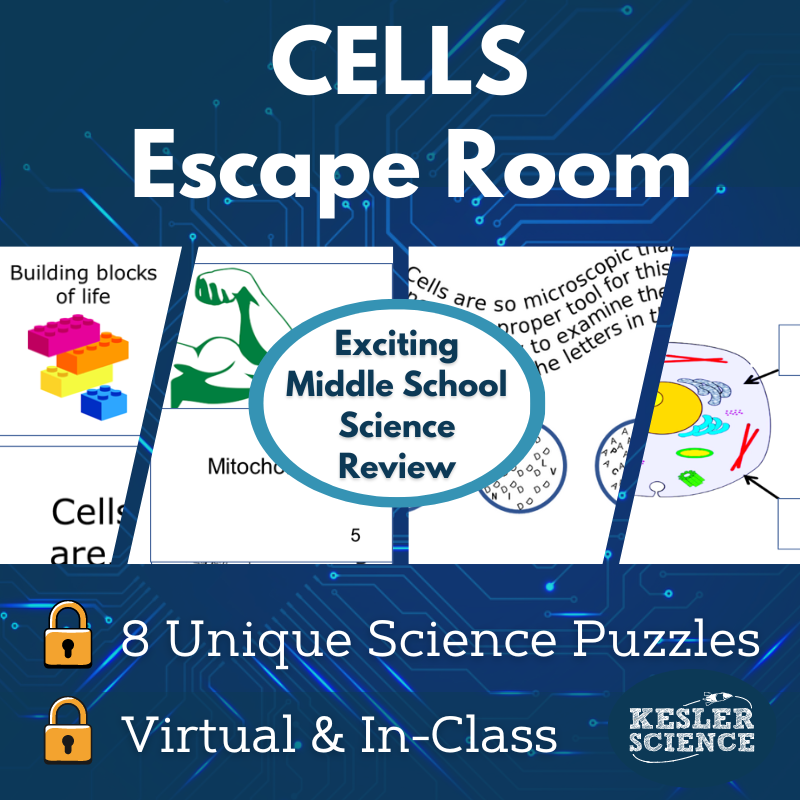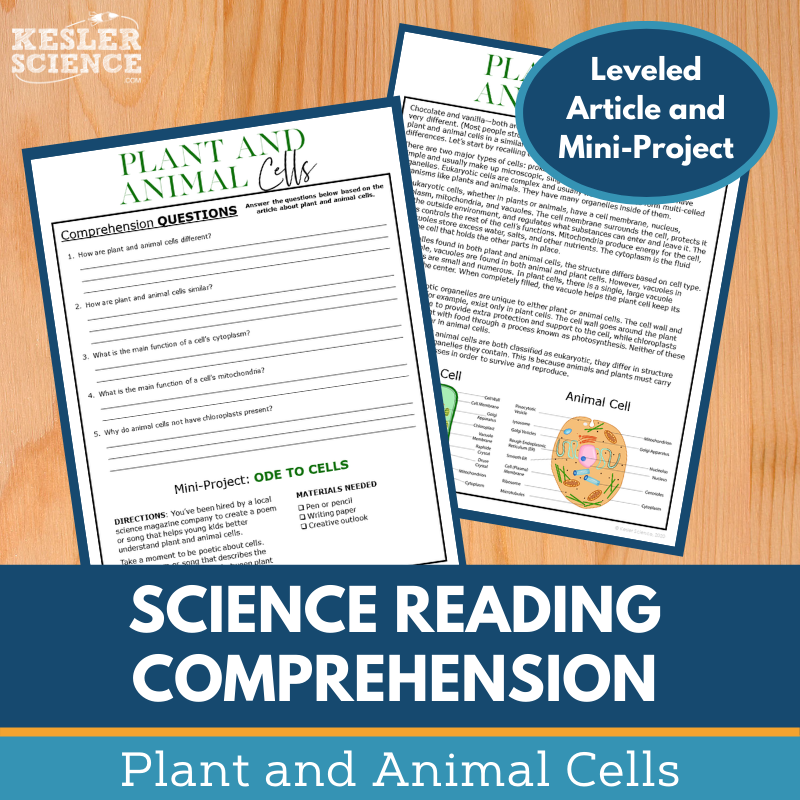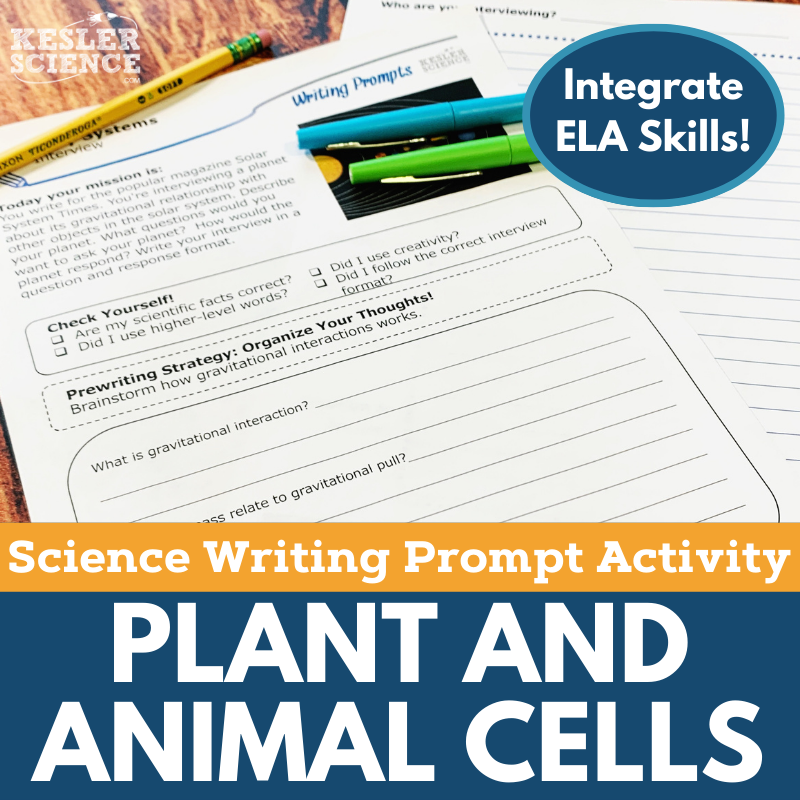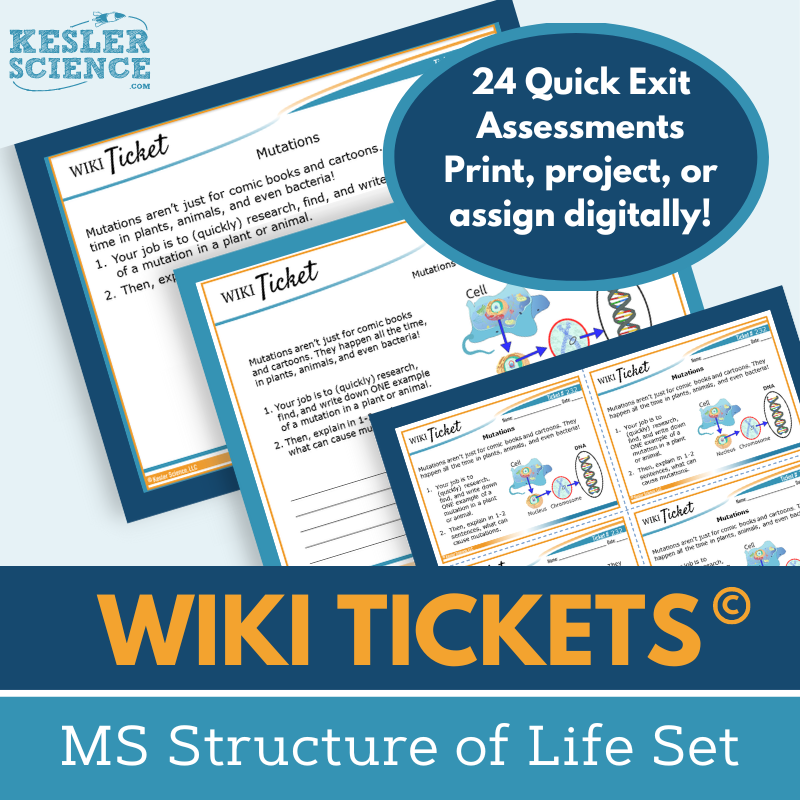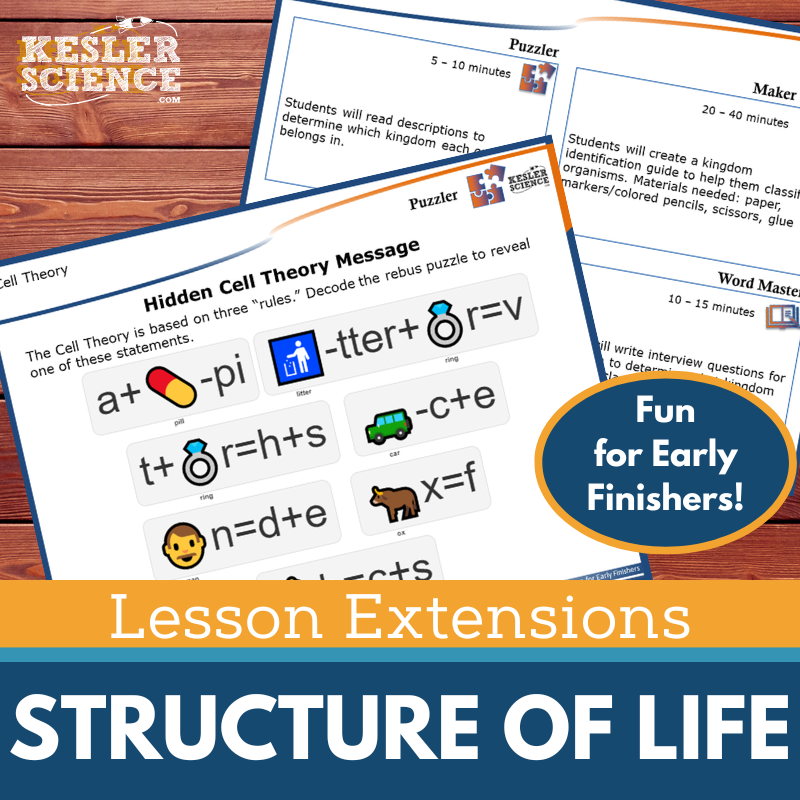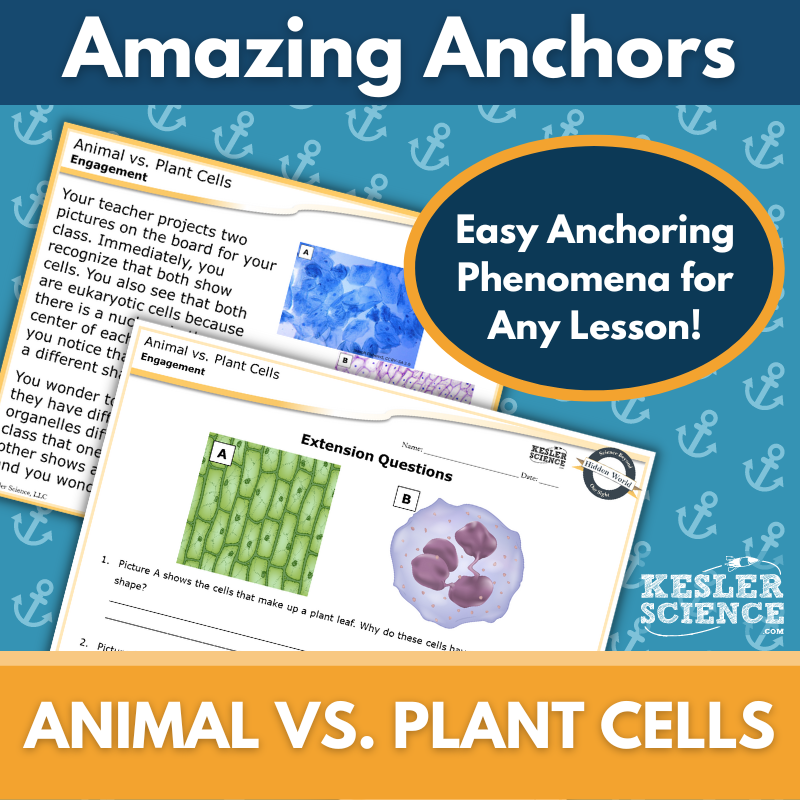Plant and Animal Cells Activities for Middle School Science
The Kesler Science Plant and Animal Cells resources offer a comprehensive, student-centered approach for teaching middle school students about the structure and function of plant and animal cell organelles. The resources below will give students a comprehensive understanding of plant and animal cells. All of the following materials are also included in the Kesler Science Membership.
The Kesler Science Plant and Animal Cells Complete 5E Lesson provides a comprehensive, student-led approach for teaching middle school students about the structure and function of plant and animal cell organelles. Designed for minimal prep and maximum student engagement, the lesson includes all necessary materials, including differentiated resources and Spanish translations to support a variety of learning needs. Students will explore essential questions, such as the differences between structure and function in cell organelles and the roles of key structures like the cell membrane, nucleus, and mitochondria.
This lesson follows the 5E Model: Engagement, Exploration, Explanation, Elaboration, and Evaluation. During the Engagement phase, students are introduced to key concepts using objectives and vocabulary cards in English and Spanish, as well as discussion prompts. In the Exploration phase, the differentiated student-led station lab encourages hands-on learning with nine stations where students explore plant and animal cells through reading, video, research, and interactive tasks.
Throughout the Explanation phase, students use editable PowerPoints and interactive notebook templates to deepen their understanding. In the Elaboration phase, student-choice projects allow learners to extend their knowledge. The Evaluation phase offers assessment questions and review materials for self-checking, class discussions, and test practice. This resource is fully adaptable for both in-person and virtual learning environments.
The Kesler Science Plant and Animal Cells Complete 5E Lesson provides a comprehensive, student-led approach for teaching middle school students about the structure and function of plant and animal cell organelles. Designed for minimal prep and maximum student engagement, the lesson includes all necessary materials, including differentiated resources and Spanish translations to support a variety of learning needs. Students will explore essential questions, such as the differences between structure and function in cell organelles and the roles of key structures like the cell membrane, nucleus, and mitochondria.
This lesson follows the 5E Model: Engagement, Exploration, Explanation, Elaboration, and Evaluation. During the Engagement phase, students are introduced to key concepts using objectives and vocabulary cards in English and Spanish, as well as discussion prompts. In the Exploration phase, the differentiated student-led station lab encourages hands-on learning with nine stations where students explore plant and animal cells through reading, video, research, and interactive tasks.
Throughout the Explanation phase, students use editable PowerPoints and interactive notebook templates to deepen their understanding. In the Elaboration phase, student-choice projects allow learners to extend their knowledge. The Evaluation phase offers assessment questions and review materials for self-checking, class discussions, and test practice. This resource is fully adaptable for both in-person and virtual learning environments.
The Kesler Science Plant and Animal Cells Station Lab offers a student-led approach that keeps middle school students engaged while learning about plant and animal cells. With eight differentiated stations, the activity provides opportunities for students to direct their own learning. The stations include materials such as signage, literature, and task cards, making it easy to facilitate independent or small group work.
The nine modular stations include both input and output activities. Input stations like "Explore It!" and "Research It!" help students encounter new concepts through hands-on demonstrations, online resources, and reading passages. Output stations such as "Organize It!" and "Illustrate It!" allow students to showcase their knowledge through manipulative tasks, drawings, and short-answer prompts.
A challenge station, "Challenge It!" provides extension activities for early finishers, reinforcing the learning through fun crosswords, games, and mini projects. These stations are flexible for virtual learning, with digital versions available for platforms like Google Slides or PowerPoint, allowing students to complete the activities both in-person or remotely.
The Kesler Science Plant and Animal Cells Station Lab offers a student-led approach that keeps middle school students engaged while learning about plant and animal cells. With eight differentiated stations, the activity provides opportunities for students to direct their own learning. The stations include materials such as signage, literature, and task cards, making it easy to facilitate independent or small group work.
The nine modular stations include both input and output activities. Input stations like "Explore It!" and "Research It!" help students encounter new concepts through hands-on demonstrations, online resources, and reading passages. Output stations such as "Organize It!" and "Illustrate It!" allow students to showcase their knowledge through manipulative tasks, drawings, and short-answer prompts.
A challenge station, "Challenge It!" provides extension activities for early finishers, reinforcing the learning through fun crosswords, games, and mini projects. These stations are flexible for virtual learning, with digital versions available for platforms like Google Slides or PowerPoint, allowing students to complete the activities both in-person or remotely.
The Kesler Science Plant and Animal Cells Student Choice Projects provide middle school students with the freedom to choose a project that matches their preferred learning style. With six project options and a "design your own" choice, students can engage in creative ways to demonstrate their understanding. Teachers can use the included grading rubric to assess projects and customize it to fit specific needs.
This flexible resource offers nine project options on a choice board, allowing students to select from various multimodal formats. Whether using paper, markers, or digital tools, the projects are designed to meet different learning needs and levels. A Teacher Directions page offers support and suggestions for success, and the editable rubric can be tailored for different assessment purposes.
Differentiated versions of the project page support students with varying abilities, with modified options for those needing remediation and advanced challenges for those ready to go further. Supplies needed are minimal, using common classroom materials like paper, markers, and scissors, with some projects also adaptable for digital completion.
The Kesler Science Plant and Animal Cells Student Choice Projects provide middle school students with the freedom to choose a project that matches their preferred learning style. With six project options and a "design your own" choice, students can engage in creative ways to demonstrate their understanding. Teachers can use the included grading rubric to assess projects and customize it to fit specific needs.
This flexible resource offers nine project options on a choice board, allowing students to select from various multimodal formats. Whether using paper, markers, or digital tools, the projects are designed to meet different learning needs and levels. A Teacher Directions page offers support and suggestions for success, and the editable rubric can be tailored for different assessment purposes.
Differentiated versions of the project page support students with varying abilities, with modified options for those needing remediation and advanced challenges for those ready to go further. Supplies needed are minimal, using common classroom materials like paper, markers, and scissors, with some projects also adaptable for digital completion.
The Kesler Science Structure of Life Interactive Notebook Bundle provides an engaging way for students to explore life science concepts through interactive activities. Designed for both print and digital use, this resource is perfect for traditional classrooms, 1:1 environments, and distance learning. Topics covered include cell theory, genetics, plant and animal cells, and more, offering a comprehensive tool for teaching the structure of life.
The digital version includes a unique interactive notebook PowerPoint that can be uploaded to platforms like Google Slides or MS Teams, complete with reflection pages, note spaces, and an answer key. A modified digital version is also provided for students needing accommodations. The paper version features blank and pre-filled templates, along with color photos to guide usage, ensuring all students can participate effectively.
With resources tailored for diverse learning needs, the Kesler Science Structure of Life Interactive Notebook Bundle supports differentiated instruction and student-centered learning. Teachers gain a versatile tool for enhancing understanding, while students build lasting connections to key life science concepts.
The Kesler Science Structure of Life Interactive Notebook Bundle provides an engaging way for students to explore life science concepts through interactive activities. Designed for both print and digital use, this resource is perfect for traditional classrooms, 1:1 environments, and distance learning. Topics covered include cell theory, genetics, plant and animal cells, and more, offering a comprehensive tool for teaching the structure of life.
The digital version includes a unique interactive notebook PowerPoint that can be uploaded to platforms like Google Slides or MS Teams, complete with reflection pages, note spaces, and an answer key. A modified digital version is also provided for students needing accommodations. The paper version features blank and pre-filled templates, along with color photos to guide usage, ensuring all students can participate effectively.
With resources tailored for diverse learning needs, the Kesler Science Structure of Life Interactive Notebook Bundle supports differentiated instruction and student-centered learning. Teachers gain a versatile tool for enhancing understanding, while students build lasting connections to key life science concepts.
The Plant and Animal Cell Organelles Inquiry Lab aligns with NGSS MS-LS1-2 and engages students in exploring the structure and function of plant and animal cell organelles. Using either a hands-on print version or a fully interactive digital version, students model cell parts using everyday items, then compare how the different components function in plant and animal cells. Both versions include comprehension questions, Claim-Evidence-Reasoning (C.E.R.) prompts, and reflection activities to deepen student understanding.
This flexible lab includes three differentiated versions to support all learners. The dependent version offers guided inquiry and procedural support for on-level students. The modified version provides the most structure, with sentence stems and multiple-choice options for students who need accommodations. The independent version challenges advanced learners with a student-led approach and minimal teacher direction. All formats are editable and compatible with Google Slides, allowing teachers to tailor the experience to their classroom needs.
The print lab requires common household materials such as bubble wrap, zip-close bags, and plastic eggs to represent cell organelles. The digital version is self-contained with interactive elements, ideal for virtual or absent learners. Each version comes with teacher resource pages, answer keys, and editable files for all three levels. This lab offers a dynamic, student-centered way to model and understand cellular structure and function.
The Plant and Animal Cell Organelles Inquiry Lab aligns with NGSS MS-LS1-2 and engages students in exploring the structure and function of plant and animal cell organelles. Using either a hands-on print version or a fully interactive digital version, students model cell parts using everyday items, then compare how the different components function in plant and animal cells. Both versions include comprehension questions, Claim-Evidence-Reasoning (C.E.R.) prompts, and reflection activities to deepen student understanding.
This flexible lab includes three differentiated versions to support all learners. The dependent version offers guided inquiry and procedural support for on-level students. The modified version provides the most structure, with sentence stems and multiple-choice options for students who need accommodations. The independent version challenges advanced learners with a student-led approach and minimal teacher direction. All formats are editable and compatible with Google Slides, allowing teachers to tailor the experience to their classroom needs.
The print lab requires common household materials such as bubble wrap, zip-close bags, and plastic eggs to represent cell organelles. The digital version is self-contained with interactive elements, ideal for virtual or absent learners. Each version comes with teacher resource pages, answer keys, and editable files for all three levels. This lab offers a dynamic, student-centered way to model and understand cellular structure and function.
The Plant and Animal Cell Identification Inquiry Lab aligns with NGSS MS-LS1-2 and engages students in observing plant and animal cells to explore how cell structure relates to function. Students compare elodea, onion, and cheek cells under a microscope and answer questions about why different cells exist, even within the same organism. Both print and digital formats include comprehension questions, C.E.R. writing prompts, and reflection sections to guide students through the modeling of cell functions.
The lab is fully differentiated with three versions—dependent, modified, and independent—to meet the needs of all learners. The dependent level includes guided instructions and inquiry prompts, the modified level adds sentence stems and simplified options, and the independent version gives students autonomy to design and conduct their lab work. In the print version, students use common materials such as microscopes, slides, iodine, and household items, while the digital version offers an entirely virtual alternative with no materials required.
This resource includes editable PowerPoints, answer keys, and teacher resource pages with directions, prep time, and materials lists. Designed for flexibility, all files are compatible with Google Slides and multiple learning platforms, allowing teachers to easily tailor the lab for classroom or virtual instruction.
The Plant and Animal Cell Identification Inquiry Lab aligns with NGSS MS-LS1-2 and engages students in observing plant and animal cells to explore how cell structure relates to function. Students compare elodea, onion, and cheek cells under a microscope and answer questions about why different cells exist, even within the same organism. Both print and digital formats include comprehension questions, C.E.R. writing prompts, and reflection sections to guide students through the modeling of cell functions.
The lab is fully differentiated with three versions—dependent, modified, and independent—to meet the needs of all learners. The dependent level includes guided instructions and inquiry prompts, the modified level adds sentence stems and simplified options, and the independent version gives students autonomy to design and conduct their lab work. In the print version, students use common materials such as microscopes, slides, iodine, and household items, while the digital version offers an entirely virtual alternative with no materials required.
This resource includes editable PowerPoints, answer keys, and teacher resource pages with directions, prep time, and materials lists. Designed for flexibility, all files are compatible with Google Slides and multiple learning platforms, allowing teachers to easily tailor the lab for classroom or virtual instruction.
The Kesler Science Cells Escape Room transforms learning into an interactive adventure where students demonstrate their knowledge of cells and organelles through engaging puzzles. With eight independent puzzles, teachers have full control over which to use and the order of play, making the activity adaptable for any class period. Whether using printed materials in manila envelopes or incorporating locks and props for a more authentic escape room feel, this resource offers a dynamic way to reinforce life science concepts.
The escape room includes all necessary materials, from teacher directions and detailed answer keys to a digital answer sheet perfect for Google Classrooms. Students can participate in a digital version using Google Slides or complete a print version at home, ensuring flexibility for virtual or in-person learning. Optional enhancements like UV pens, magnifying glasses, or microscopes add excitement to the experience.
With a video challenge to set the mood, printable reward templates, and editable props, this escape room encourages teamwork and problem-solving. It’s a perfect way to captivate students, foster collaboration, and deepen their understanding of cells in a fun, immersive setting.
The Kesler Science Cells Escape Room transforms learning into an interactive adventure where students demonstrate their knowledge of cells and organelles through engaging puzzles. With eight independent puzzles, teachers have full control over which to use and the order of play, making the activity adaptable for any class period. Whether using printed materials in manila envelopes or incorporating locks and props for a more authentic escape room feel, this resource offers a dynamic way to reinforce life science concepts.
The escape room includes all necessary materials, from teacher directions and detailed answer keys to a digital answer sheet perfect for Google Classrooms. Students can participate in a digital version using Google Slides or complete a print version at home, ensuring flexibility for virtual or in-person learning. Optional enhancements like UV pens, magnifying glasses, or microscopes add excitement to the experience.
With a video challenge to set the mood, printable reward templates, and editable props, this escape room encourages teamwork and problem-solving. It’s a perfect way to captivate students, foster collaboration, and deepen their understanding of cells in a fun, immersive setting.
The Kesler Science Plant and Animal Cells Reading Comprehension lesson helps middle school students explore the differences between plant and animal cell structures and functions. Students read a nonfiction article and then answer comprehension questions to deepen their understanding of the material. The lesson also includes a creative mini-project where students write a poem or song to describe the similarities and differences between plant and animal cells.
This resource includes two leveled articles (Lexile levels: 1100-1300) to accommodate different reading levels. Students also benefit from the included Cornell notes template and colorful graphics that can be printed in grayscale. The hands-on mini-project engages students in applying their knowledge creatively while reinforcing the concepts learned.
Perfect for both in-class and virtual learning environments, this resource includes files compatible with platforms like Google Classroom, MS Teams, Schoology, and Canvas. The lesson helps build science literacy, supports student comprehension, and provides teachers with flexible options for assignments, including use as extra credit or sub plans.
The Kesler Science Plant and Animal Cells Reading Comprehension lesson helps middle school students explore the differences between plant and animal cell structures and functions. Students read a nonfiction article and then answer comprehension questions to deepen their understanding of the material. The lesson also includes a creative mini-project where students write a poem or song to describe the similarities and differences between plant and animal cells.
This resource includes two leveled articles (Lexile levels: 1100-1300) to accommodate different reading levels. Students also benefit from the included Cornell notes template and colorful graphics that can be printed in grayscale. The hands-on mini-project engages students in applying their knowledge creatively while reinforcing the concepts learned.
Perfect for both in-class and virtual learning environments, this resource includes files compatible with platforms like Google Classroom, MS Teams, Schoology, and Canvas. The lesson helps build science literacy, supports student comprehension, and provides teachers with flexible options for assignments, including use as extra credit or sub plans.
The Kesler Science Plant and Animal Cells Writing Prompt Activity engages middle school students with a creative invention-based writing exercise that reinforces life science concepts. This activity enhances students’ reasoning and exploration skills while allowing them to showcase their knowledge through writing. Designed for maximum flexibility, it works seamlessly in both in-person and virtual classrooms, keeping students engaged wherever they learn.
This resource includes teacher directions, project ideas, and editable rubrics for easy assessment. Students can use full-sized or half-sheet handouts for pre-writing, self-checks, and detailed layout templates, available in both printable and digital formats. The interactive version is compatible with PowerPoint and Google Slides, making it perfect for any teaching environment.
Ideal for cross-curricular activities, pre-tests, differentiation exercises, or early finisher tasks, this low-prep, high-quality resource supports elaboration and review. Whether used for extra credit or as a TELPAS writing sample, it encourages students to think critically while creatively expressing their understanding of plant and animal cells.
The Kesler Science Plant and Animal Cells Writing Prompt Activity engages middle school students with a creative invention-based writing exercise that reinforces life science concepts. This activity enhances students’ reasoning and exploration skills while allowing them to showcase their knowledge through writing. Designed for maximum flexibility, it works seamlessly in both in-person and virtual classrooms, keeping students engaged wherever they learn.
This resource includes teacher directions, project ideas, and editable rubrics for easy assessment. Students can use full-sized or half-sheet handouts for pre-writing, self-checks, and detailed layout templates, available in both printable and digital formats. The interactive version is compatible with PowerPoint and Google Slides, making it perfect for any teaching environment.
Ideal for cross-curricular activities, pre-tests, differentiation exercises, or early finisher tasks, this low-prep, high-quality resource supports elaboration and review. Whether used for extra credit or as a TELPAS writing sample, it encourages students to think critically while creatively expressing their understanding of plant and animal cells.
The Kesler Science WIKI Tickets are flexible, engaging formative assessments designed for middle school science topics. The Structure of Life Set includes 24 colorful assessments that can be used as exit tickets, bellringers, or quick checks for understanding. Each topic features five formats: a projection version, three print sizes, and an interactive digital version compatible with PowerPoint or Google Slides.
Aligned with NGSS and TEKS standards, these assessments cover key topics like plant and animal cells, cell functions, heredity, homeostasis, and turgor pressure. The included table of contents helps teachers easily identify alignment with specific standards, ensuring comprehensive coverage. With options for both in-class and virtual learning, these assessments offer maximum flexibility.
These "What I Know Is" assessments provide teachers with a clear picture of student understanding. Whether used in a traditional classroom or a remote setting, they are an easy, engaging way to track progress and identify learning gaps.
The Kesler Science WIKI Tickets are flexible, engaging formative assessments designed for middle school science topics. The Structure of Life Set includes 24 colorful assessments that can be used as exit tickets, bellringers, or quick checks for understanding. Each topic features five formats: a projection version, three print sizes, and an interactive digital version compatible with PowerPoint or Google Slides.
Aligned with NGSS and TEKS standards, these assessments cover key topics like plant and animal cells, cell functions, heredity, homeostasis, and turgor pressure. The included table of contents helps teachers easily identify alignment with specific standards, ensuring comprehensive coverage. With options for both in-class and virtual learning, these assessments offer maximum flexibility.
These "What I Know Is" assessments provide teachers with a clear picture of student understanding. Whether used in a traditional classroom or a remote setting, they are an easy, engaging way to track progress and identify learning gaps.
The Kesler Science Structure of Life Lesson Extensions provide student-choice activities designed to keep fast finishers engaged with critical thinking and creative tasks. These extensions are perfect for wrapping up lessons, filling time during testing, or offering advanced learners opportunities to deepen their understanding of life science concepts. Aligned with NGSS and TEKS standards, the extensions include activities such as puzzles, hands-on Maker Space projects, digital media tasks, and creative writing challenges.
Each Lesson Extension includes teacher directions, answer keys, and both projection and printable versions for maximum flexibility. With topics ranging from cell structure to heredity and natural selection, students can explore concepts through problem-solving, STEAM connections, and creative expression. These activities encourage deeper exploration of topics like artificial selection, genetic mutations, and environmental factors.
Kesler Science Lesson Extensions are ideal for scaffolding learning or challenging independent learners. By incorporating engaging activities like Puzzler, Maker Space, Tech Connection, and Word Master, these resources provide rigorous yet enjoyable options to enrich life science lessons.
The Kesler Science Structure of Life Lesson Extensions provide student-choice activities designed to keep fast finishers engaged with critical thinking and creative tasks. These extensions are perfect for wrapping up lessons, filling time during testing, or offering advanced learners opportunities to deepen their understanding of life science concepts. Aligned with NGSS and TEKS standards, the extensions include activities such as puzzles, hands-on Maker Space projects, digital media tasks, and creative writing challenges.
Each Lesson Extension includes teacher directions, answer keys, and both projection and printable versions for maximum flexibility. With topics ranging from cell structure to heredity and natural selection, students can explore concepts through problem-solving, STEAM connections, and creative expression. These activities encourage deeper exploration of topics like artificial selection, genetic mutations, and environmental factors.
Kesler Science Lesson Extensions are ideal for scaffolding learning or challenging independent learners. By incorporating engaging activities like Puzzler, Maker Space, Tech Connection, and Word Master, these resources provide rigorous yet enjoyable options to enrich life science lessons.
This Amazing Anchors Phenomenon Lesson introduces animal and plant cells through a real-world lens. Students begin with an introductory reading that compares two cell images, paired with comprehension and extension questions to spark curiosity. A second, explanatory reading clearly outlines the differences and functions of animal and plant cells, reinforcing understanding through additional questions.
The no-prep resource includes teacher directions with answer keys, editable projection slides, and both print and digital versions to suit classroom or virtual settings. Materials come as full- and half-page handouts, easily integrated into interactive notebooks and LMS platforms. A modified version is also provided, supporting differentiated instruction with simplified language and sentence starters.
Designed to bookend a science lesson, these phenomenon pages are ideal for the Engage and Elaborate phases of the 5E Model. They serve as effective supplemental tools for introducing or reviewing key concepts in a middle school life science unit on cells.
This Amazing Anchors Phenomenon Lesson introduces animal and plant cells through a real-world lens. Students begin with an introductory reading that compares two cell images, paired with comprehension and extension questions to spark curiosity. A second, explanatory reading clearly outlines the differences and functions of animal and plant cells, reinforcing understanding through additional questions.
The no-prep resource includes teacher directions with answer keys, editable projection slides, and both print and digital versions to suit classroom or virtual settings. Materials come as full- and half-page handouts, easily integrated into interactive notebooks and LMS platforms. A modified version is also provided, supporting differentiated instruction with simplified language and sentence starters.
Designed to bookend a science lesson, these phenomenon pages are ideal for the Engage and Elaborate phases of the 5E Model. They serve as effective supplemental tools for introducing or reviewing key concepts in a middle school life science unit on cells.
Year-Round Resources
These year-round activities will increase your students' understanding of many middle school science topics. All of these activities are also included in the Kesler Science Membership.
Visual Data & Graphing
You're not alone if your students struggle with understanding graphs, charts, and tables. It's a skill that takes an enormous amount of practice. This resource will help students build a strong foundation in analyzing data and creating their own data visualizations.
Bell Ringers and Warm-Ups
These middle school science bell ringers are an excellent way to engage your students as soon as they walk into your classroom. This comprehensive FULL YEAR resource includes everything you need to start off each science class with an interesting warm-up activity.
Review Board Games
Each game board has been carefully designed to keep students engaged. There are 10 different action spaces on each board and dozens of question cards. All of the actions are related to science concepts and keep the students motivated throughout the game.
Each game is ready to play. Simply print out the board and the cards and let the students enjoy reviewing nine different units.
Essential Questions
Below are the essential questions associated with the lessons and activities included in this unit. This topic is only one of more than 100 middle school science topics included in the Kesler Science Membership.
-
What is the difference between structure and function in plant and animal cell organelles?
-
What is a cell membrane, cell wall, nucleus, cytoplasm, mitochondria, chloroplast, and vacuole?
Kesler Science Membership
Imagine never having to search for another middle school science lesson again. The membership gives you access to ALL of the Kesler Science products in one place (Yes, including everything above).
Say goodbye to long hours of lesson prep.

